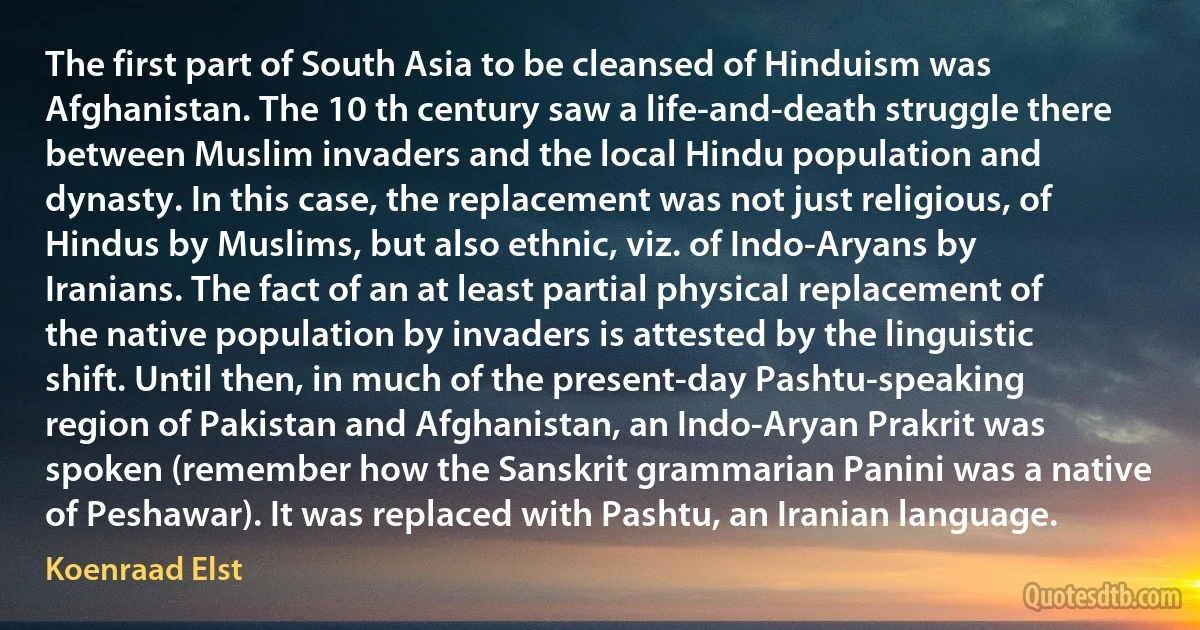
The first part of South Asia to be cleansed of Hinduism was Afghanistan. The 10 th century saw a life-and-death struggle there between Muslim invaders and the local Hindu population and dynasty. In this case, the replacement was not just religious, of Hindus by Muslims, but also ethnic, viz. of Indo-Aryans by Iranians. The fact of an at least partial physical replacement of the native population by invaders is attested by the linguistic shift. Until then, in much of the present-day Pashtu-speaking region of Pakistan and Afghanistan, an Indo-Aryan Prakrit was spoken (remember how the Sanskrit grammarian Panini was a native of Peshawar). It was replaced with Pashtu, an Iranian language.
Koenraad ElstRelated topics
case century dynasty ethnic grammarian hindu hinduism iranian language least partial region saw speak viz asia afghanistan paniniRelated quotes
Even the strongest advocate of the Aryan invasion theory cannot, in all honesty, point out any specific spot outside India to which the origin of any, simply any, aspect of Hinduism could be attributed. Even if, for the purpose of this chapter, it is presumed that the 'Aryans' came from outside India, and that they imposed the Hindu religion on local inhabitants (two questions which will be dealt with subsequently in this book), it will have to be admitted that there is no trace of any foreign connections in Hinduism, much less the consciousness, of any such connections, among Hindus-and least of all, any foreign loyalties, associable with such foreign connections".

Shrikant Talageri
While I am a Hindu, Mir Mushtaq who is presiding over this meeting is a Muslim. Mr. Frank Anthony who has addressed you is a Christian. There are also Sikhs and Parsis here. The unique thing about our country is that we have Hindus, Muslims, Christians, Sikhs, Parsis and people of all other religions. We have temples and mosques, gurdwaras and churches. But we do not bring all this into politics. This is the difference between India and Pakistan. Whereas Pakistan proclaims herself to be an Islamic State and uses religion as a political factor, we Indians have the freedom to follow whatever religion we may choose, and worship in any way we please. So far as politics is concerned, each of us is as much an Indian as the other.

Lal Bahadur Shastri
India though it has more than five hundred spoken dialects, has only one sacred language and only one sacred literature, accepted and revered by all adherence of Hinduism alike, however diverse in race, dialect, rank and creed. That language is Sanskrit and Sanskrit literature, the only repository of the Veda or knowledge in its widest sense, the only vehicle of Hindu mythology, philosophy, law, the mirror in which all the creeds, opinions, and customs and usages of the Hindus are faithfully reflected and the only quarry whence the requisite materials may be obtained for improving the vernaculars or for expressing important religious and scientific ideas.

Monier Monier-Williams
Therefore, the Hindus and Sikhs, the minorities in the new Muslim homeland, were not to be suffered to stay there. This "minorityism”, the name for Hindus and Sikhs, was "the major enemy of the Milltat,” as Rehmat Ali, one of the early League leaders and intellectuals and coiner of the word Pakistan, said. According to its original conception, Pakistan itself was to be larger than it turned out to be; it was to include Kashmir, Assam and Bengal in the East and Hyderabad and Malabar in the South and many independent Muslim states within the rest of the Indian territory. India, or whatever remained of India, was itself to be considered Dinia, an important Islamic concept.

Ram Swarup
The Belarusian failure therefore provides a useful test. Here we have an "ethnic group” which is the largest by far in the area in question. According to the Russian imperial census of 1897, more people spoke Belarusian in Vil'na province than all other languages combined. In Vil'na, Minsk, Grodno, Mogilev, and Vitebsk provinces, contiguous territories of historic Lithuania, speakers of Belarusian were three quarters of the population. In the twentieth century, this "ethnic group” did not become a modern nation. In combination with Lithuanian and Polish successes, this Belarusian failure helps us to perceive what national movements actually need.

Timothy D. Snyder
